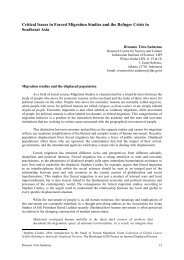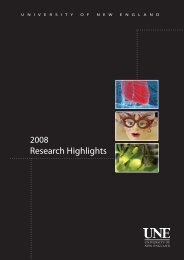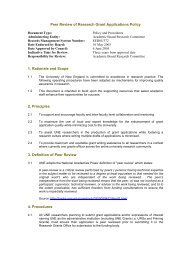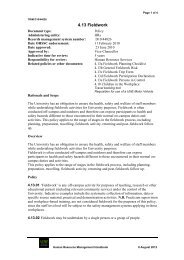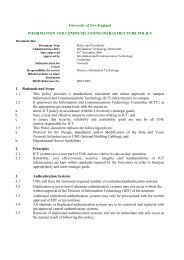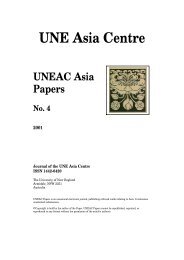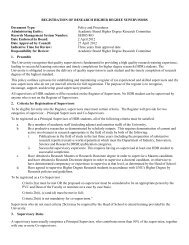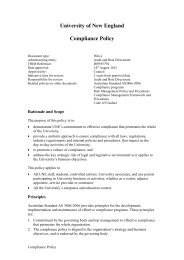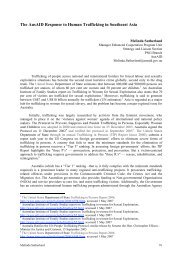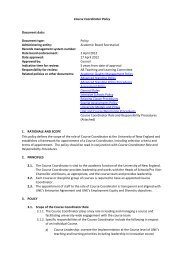Logistics Management in China - University of New England
Logistics Management in China - University of New England
Logistics Management in China - University of New England
You also want an ePaper? Increase the reach of your titles
YUMPU automatically turns print PDFs into web optimized ePapers that Google loves.
UNE Asia Centre<br />
UNEAC Asia<br />
Papers<br />
No. 5<br />
2002<br />
Journal <strong>of</strong> the UNE Asia Centre<br />
ISSN 1442-6420<br />
The <strong>University</strong> <strong>of</strong> <strong>New</strong> <strong>England</strong><br />
Armidale, NSW 2351<br />
Australia<br />
UNEAC Papers is an occasional electronic journal, publish<strong>in</strong>g refereed works relat<strong>in</strong>g to Asia. It welcomes<br />
unsolicited submissions.<br />
©Copyright is held by the author <strong>of</strong> the Paper. UNEAC Papers cannot be republished, repr<strong>in</strong>ted, or<br />
reproduced <strong>in</strong> any format without the permission <strong>of</strong> the article's author/s.
Editorial Board<br />
Associate Pr<strong>of</strong>essor Howard Brasted, Director, Asia Centre<br />
Adjunct Pr<strong>of</strong>essor Ian Metcalfe, Deputy Director, Asia Centre<br />
Pr<strong>of</strong>essor Amarjit Kaur, Faculty <strong>of</strong> Economics, Bus<strong>in</strong>ess and Law<br />
Pr<strong>of</strong>essor Acram Taji, Faculty <strong>of</strong> the Sciences<br />
Dr Graham Young, Faculty <strong>of</strong> Arts<br />
Dr David Laird, Faculty <strong>of</strong> Education, Health and Pr<strong>of</strong>essional Studies<br />
Editor <strong>of</strong> this issue: Pr<strong>of</strong>essor Ian Metcalfe, Deputy Director, Asia Centre.<br />
Editorial Adsvisory Board<br />
Pr<strong>of</strong>essor Malcolm Falkus, <strong>University</strong> <strong>of</strong> <strong>New</strong> <strong>England</strong><br />
Pr<strong>of</strong>essor Robert Hall, <strong>University</strong> <strong>of</strong> London<br />
Pr<strong>of</strong>essor Brian Stoddart, <strong>University</strong> <strong>of</strong> <strong>New</strong> <strong>England</strong><br />
Pr<strong>of</strong>essor Richard Robison, Murdoch <strong>University</strong><br />
Pr<strong>of</strong>essor Prakash Kumar, National <strong>University</strong> <strong>of</strong> S<strong>in</strong>gapore<br />
Dr Ken Jackson, <strong>University</strong> <strong>of</strong> Auckland, <strong>New</strong> Zealand<br />
CONTENTS<br />
No. 5, 2002<br />
Felix W.H. Chan <strong>Logistics</strong> <strong>Management</strong> <strong>in</strong> Ch<strong>in</strong>a: 1<br />
Barrier-hurdl<strong>in</strong>g and the Outlook for<br />
Legal Solutions
<strong>Logistics</strong> <strong>Management</strong> <strong>in</strong> Ch<strong>in</strong>a:<br />
Barrier-hurdl<strong>in</strong>g and the Outlook for Legal Solutions<br />
Felix W.H. Chan<br />
Faculty <strong>of</strong> Law<br />
<strong>University</strong> <strong>of</strong> Hong Kong<br />
Pokfulam Road<br />
Hong Kong<br />
Email: fwhchan@hku.hk<br />
Abstract<br />
Ch<strong>in</strong>a is an important <strong>in</strong>vestment dest<strong>in</strong>ation for mult<strong>in</strong>ational corporations. Foreign <strong>in</strong>vestors have<br />
flocked to Ch<strong>in</strong>a to take advantage <strong>of</strong> the open door policy. It is anticipated that a more extensive<br />
market open<strong>in</strong>g after Ch<strong>in</strong>a’s entry <strong>in</strong>to the World Trade Organisation (WTO) will further boost its<br />
foreign trade and <strong>in</strong>vestment.<br />
Unfortunately, most foreign firms have faced logistical problems <strong>in</strong> connection with the flow <strong>of</strong><br />
<strong>in</strong>formation and materials <strong>in</strong> Ch<strong>in</strong>a. A review <strong>of</strong> the literature concern<strong>in</strong>g logistics and transport<br />
research <strong>in</strong>dicates that although the major barriers to logistics management have been identified, a vital<br />
aspect – the legal environment <strong>in</strong> Ch<strong>in</strong>a – has largely been ignored. The present study attempts to fill<br />
this void <strong>of</strong> empirical evidence by identify<strong>in</strong>g the magnitude <strong>of</strong> l<strong>in</strong>kages between Ch<strong>in</strong>a’s legal<br />
environment and its logistical capabilities<br />
Introduction<br />
Ch<strong>in</strong>a is an important <strong>in</strong>vestment dest<strong>in</strong>ation for mult<strong>in</strong>ational corporations. Over the past<br />
two decades, the Ch<strong>in</strong>ese economy has undergone considerable growth. Despite Asian and<br />
global f<strong>in</strong>ancial crises, Ch<strong>in</strong>a’s economy is still grow<strong>in</strong>g. By the end <strong>of</strong> 2000, Ch<strong>in</strong>a<br />
approved 365,974 foreign <strong>in</strong>vestment projects, with contracted and actual utilised overseas<br />
foreign direct <strong>in</strong>vestment amount<strong>in</strong>g to US$676.7 billion and US$348.6 billion. The lead<strong>in</strong>g<br />
sources <strong>of</strong> <strong>in</strong>vestment were Hong Kong, Taiwan, S<strong>in</strong>gapore, Japan, the US, and South Korea.<br />
Follow<strong>in</strong>g the establishment <strong>in</strong> 1980 <strong>of</strong> the Beij<strong>in</strong>g Aviation Food Company, the country saw<br />
the registration <strong>of</strong> more than 150,000 S<strong>in</strong>o-foreign jo<strong>in</strong>t ventures to March 2001 (People’s<br />
Daily 2001). Five ma<strong>in</strong>land Ch<strong>in</strong>ese firms are currently <strong>in</strong> the “Fortune Top 500” list: the<br />
Industrial and Commercial Bank <strong>of</strong> Ch<strong>in</strong>a, Ch<strong>in</strong>a Petrochemical Corporation, the Bank <strong>of</strong><br />
Ch<strong>in</strong>a, the Ch<strong>in</strong>a National Chemical Import and Export Corporation, and the Ch<strong>in</strong>a National<br />
Cereals, Oils and Foodstuff Import and Export Corporation. It is forecasted that “economic<br />
policy <strong>in</strong> 2001-02 will be dom<strong>in</strong>ated by two trends: expansionary monetary and fiscal<br />
∗<br />
Revised version <strong>of</strong> a paper presented at the <strong>New</strong> Zealand Asian Studies Society 14 th International<br />
Conference, 28- 30 November 2001, hosted by the <strong>University</strong> <strong>of</strong> Canterbury at Christchurch, <strong>New</strong><br />
Zealand.<br />
Felix W.H. Chan 1
policies aimed at bolster<strong>in</strong>g overall GDP growth, and <strong>of</strong>ficial efforts to push through vital<br />
structural reforms” (Economist Intelligence Unit, May 2001). Ch<strong>in</strong>a’s gross domestic<br />
product (GDP) <strong>in</strong>creased <strong>in</strong> real terms by an average <strong>of</strong> 8.3% from 1996 to 2000:<br />
Table 1: Ch<strong>in</strong>a’s GDP<br />
1996 1997 1998 1999 2000<br />
Real GDP Growth 9.6% 8.8% 7.8% 7.2% 8.0%<br />
Exports <strong>of</strong> goods 151.1 182.7 183.5 194.7 249<br />
(US$ billion)<br />
Imports <strong>of</strong> goods<br />
(US$ billion)<br />
131.5 136.4 136.9 158.5 216.1<br />
Source: Economist Intelligence Unit, May 2001<br />
Foreign <strong>in</strong>vestors have flocked to Ch<strong>in</strong>a to take advantage <strong>of</strong> the open door policy, low<br />
labour costs, and the potentially huge market. Most <strong>of</strong> the global companies are located <strong>in</strong> the<br />
Shanghai, Beij<strong>in</strong>g, and Guangdong regions. It is anticipated that a more extensive market<br />
open<strong>in</strong>g after Ch<strong>in</strong>a’s entry <strong>in</strong>to World Trade Organisation (WTO) will further boost its<br />
foreign trade and <strong>in</strong>vestment.<br />
Unfortunately, most foreign firms have faced logistical problems <strong>in</strong> connection with the flow<br />
<strong>of</strong> <strong>in</strong>formation and the transportation <strong>of</strong> their materials <strong>in</strong> Ch<strong>in</strong>a. A review <strong>of</strong> the literature<br />
concern<strong>in</strong>g logistics and transport <strong>in</strong>dicates that although major barriers to logistics<br />
management have been identified, a vital aspect – the legal environment <strong>in</strong> Ch<strong>in</strong>a – has<br />
largely been ignored. It is acknowledged that an array <strong>of</strong> research has been conducted to<br />
analyse how the different economic, political, operational, and cultural environments <strong>in</strong> a<br />
country can create various logistical barriers to a firm’s global operation. Nevertheless, there<br />
has been little qualitative evidence that relates the characteristics <strong>of</strong> Ch<strong>in</strong>a’s logistics<br />
management to its legal environment. This study attempts to fill that void by identify<strong>in</strong>g the<br />
magnitude <strong>of</strong> l<strong>in</strong>kages between Ch<strong>in</strong>a’s legal environment and its logistical capabilities. The<br />
theory to be established through research is that further legal reform <strong>in</strong> Ch<strong>in</strong>a, <strong>in</strong> l<strong>in</strong>e with<br />
WTO entry and globalisation, is necessary and can play a significant role <strong>in</strong> improv<strong>in</strong>g the<br />
logistical environment. The objectives <strong>of</strong> this study are achieved through exploratory<br />
<strong>in</strong>terviews with expatriate logistics managers stationed <strong>in</strong> Ch<strong>in</strong>a, logistics consultants, and<br />
transport lawyers. All <strong>of</strong> the respondents possessed first hand experience and orig<strong>in</strong>al<br />
<strong>in</strong>formation about Ch<strong>in</strong>a’s transportation concerns. In light <strong>of</strong> the fact that Ch<strong>in</strong>a has<br />
<strong>of</strong>ficially become a member <strong>of</strong> WTO <strong>in</strong> November 2001, Ch<strong>in</strong>a is now actively amend<strong>in</strong>g its<br />
exist<strong>in</strong>g laws and promulgat<strong>in</strong>g new legislation <strong>in</strong> compliance with WTO goals. Therefore,<br />
this empirical study is timely and appropriate to test the cause and affect relationships as<br />
suggested <strong>in</strong> the aforementioned framework.<br />
Objectives<br />
The specific research objectives are:<br />
(1) To identify the logistics barriers that foreign firms have encountered <strong>in</strong> Ch<strong>in</strong>a, and<br />
how the firms evaluate the relative severity <strong>of</strong> these barriers.<br />
UNEAC Asia Papers No. 5 2002 2
(2) To assess the extent to which logistics barriers <strong>in</strong> Ch<strong>in</strong>a are related to its legal<br />
environment.<br />
(3) To understand how the imm<strong>in</strong>ent legal reforms <strong>in</strong> l<strong>in</strong>e with Ch<strong>in</strong>a’s entry <strong>in</strong>to the<br />
WTO are expected to facilitate the reduction <strong>of</strong> logistics barriers <strong>in</strong> Ch<strong>in</strong>a and to help<br />
improve the performance <strong>of</strong> logistical functions.<br />
The results have implications not only for researchers, <strong>in</strong> that they reveal <strong>in</strong>terest<strong>in</strong>g <strong>in</strong>sights<br />
that po<strong>in</strong>t to areas <strong>in</strong> which more research is needed, but also for the Western managers <strong>of</strong><br />
foreign <strong>in</strong>vestments <strong>in</strong> Ch<strong>in</strong>a, by <strong>in</strong>dicat<strong>in</strong>g the areas <strong>in</strong> which those managers are most likely<br />
to encounter problems. These issues are critical for the successful formulation <strong>of</strong> <strong>in</strong>novative<br />
and responsive logistical strategies.<br />
Review <strong>of</strong> Background Literature<br />
The concepts <strong>of</strong> supply cha<strong>in</strong>s and logistics are closely connected. A supply cha<strong>in</strong><br />
encompasses all activities and functions <strong>in</strong>volved <strong>in</strong> fulfill<strong>in</strong>g a customer request. It <strong>in</strong>cludes<br />
the suppliers <strong>of</strong> raw materials, manufacturers, transporters, warehouses, retailers, and the<br />
customers themselves. The functions <strong>in</strong>clude the flow <strong>of</strong> <strong>in</strong>formation, and the transformation<br />
and delivery <strong>of</strong> goods from raw material stage through to the end user (Handfield and Nichols<br />
1999 p. 2; Chopra and Me<strong>in</strong>dl 2001, p. 3). Significant factors that determ<strong>in</strong>e the success <strong>of</strong> a<br />
supply cha<strong>in</strong> <strong>in</strong>clude process <strong>in</strong>tegration among the suppliers and buyers, networks that<br />
connect the partners, and market sensitivity on the basis <strong>of</strong> <strong>in</strong>formation <strong>in</strong>stead <strong>of</strong> <strong>in</strong>ventory<br />
(Christopher 2000, p.38-9). Effective logistics is a key to the success <strong>of</strong> any supply cha<strong>in</strong>.<br />
Novack, R<strong>in</strong>ehart and Langley (1994, p. 114) def<strong>in</strong>e logistics as follows:<br />
<strong>Logistics</strong> is the process <strong>of</strong> plann<strong>in</strong>g, implement<strong>in</strong>g, and controll<strong>in</strong>g the efficient,<br />
effective flow and storage <strong>of</strong> raw materials, <strong>in</strong>-process <strong>in</strong>ventory, f<strong>in</strong>ished goods,<br />
services, and related <strong>in</strong>formation from po<strong>in</strong>t <strong>of</strong> orig<strong>in</strong> to po<strong>in</strong>t <strong>of</strong> consumption<br />
(<strong>in</strong>clud<strong>in</strong>g <strong>in</strong>bound, outbound, <strong>in</strong>ternal, and external movements) for the purpose <strong>of</strong><br />
conform<strong>in</strong>g to customer requirements.<br />
For <strong>in</strong>stance, the number <strong>of</strong> Internet users <strong>in</strong> Ch<strong>in</strong>a <strong>in</strong>creased by 4 million <strong>in</strong> the first half <strong>of</strong><br />
2001. A report by the government-funded Ch<strong>in</strong>a Internet Network Information Centre<br />
revealed that 26.5 million people are now us<strong>in</strong>g the Internet <strong>in</strong> Ch<strong>in</strong>a (Ch<strong>in</strong>a Daily 2001a).<br />
With the rapid penetration <strong>of</strong> the Internet and the advent <strong>of</strong> e-commerce over the Internet,<br />
customers <strong>in</strong> even the most remote regions <strong>of</strong> Ch<strong>in</strong>a can now place orders for goods onl<strong>in</strong>e.<br />
As home deliveries <strong>of</strong> all goods grow with e-commerce, efficient logistics will play a major<br />
role <strong>in</strong> the success <strong>of</strong> these supply cha<strong>in</strong>s. In Ch<strong>in</strong>a, the major players <strong>in</strong> supply cha<strong>in</strong><br />
logistics <strong>in</strong>clude the follow<strong>in</strong>g (HK Trade Development Council 2000, p.2):<br />
• Airl<strong>in</strong>es;<br />
• Consignees;<br />
• Consolidators;<br />
• Free Trade Zones;<br />
• Freight Forwarders;<br />
• <strong>Logistics</strong> Centres;<br />
• Manufacturers;<br />
Felix W.H. Chan 3
• Retailers and Wholesalers;<br />
• Shippers;<br />
• Shipp<strong>in</strong>g L<strong>in</strong>es;<br />
• Truck<strong>in</strong>g Companies; and<br />
• Warehous<strong>in</strong>g and Distribution Companies.<br />
A Free Trade Zone (FTZ) is a zone normally located <strong>in</strong> a port area. The Ch<strong>in</strong>ese government<br />
has approved 15 such zones <strong>in</strong> Ch<strong>in</strong>a. The Zhuhai FTZ <strong>in</strong> Southern Ch<strong>in</strong>a, established under<br />
the “Regulation <strong>of</strong> Zhuhai Free Trade Zone” approved at the 30 th Session <strong>of</strong> the Stand<strong>in</strong>g<br />
Committee <strong>of</strong> the Fourth Zhuhai People’s Congress, is one <strong>of</strong> the good examples illustrat<strong>in</strong>g<br />
the flexible logistical environment <strong>in</strong> a FTZ. Accord<strong>in</strong>g to Zhuhai FTZ (2001), <strong>in</strong>-zone<br />
enterprises and the customs <strong>of</strong>fice are connected by a computer system, and Electronic Data<br />
Interchange is <strong>in</strong> use. No quotas or licenses for import and export are required <strong>in</strong> the FTZ.<br />
Many warehouses and showrooms are present. The warehous<strong>in</strong>g enterprises <strong>in</strong> the FTZ can<br />
store goods demanded <strong>in</strong> the domestic and <strong>in</strong>ternational markets, with the exception <strong>of</strong> those<br />
prohibited by law. There is no time limit for the storage <strong>of</strong> goods for transit, and the transit<br />
goods may undergo process<strong>in</strong>g, grad<strong>in</strong>g, and repackag<strong>in</strong>g <strong>in</strong> the FTZ. Foreign <strong>in</strong>vestors’<br />
supply cha<strong>in</strong> activities <strong>in</strong> the FTZ, such as imports, exports, warehous<strong>in</strong>g, and transportation,<br />
can take place freely. The FTZ policy shows that the Ch<strong>in</strong>ese government is determ<strong>in</strong>ed to<br />
liberalise and encourage free trade and commerce.<br />
S<strong>in</strong>ce the Ch<strong>in</strong>ese government has been actively formulat<strong>in</strong>g policies to encourage a stronger<br />
l<strong>in</strong>kage between the national economy and the global economy, more and more <strong>in</strong>ternational<br />
firms have been <strong>in</strong>volved <strong>in</strong> foreign direct <strong>in</strong>vestment <strong>in</strong> Ch<strong>in</strong>a. A new economic order has<br />
both shaped and been shaped by the extraord<strong>in</strong>ary pace <strong>of</strong> globalisation that makes Ch<strong>in</strong>a<br />
vastly more competitive than ever before. Globalisation has been considered as the most<br />
significant phenomenon <strong>in</strong>fluenc<strong>in</strong>g societies s<strong>in</strong>ce the 1990s. Waters (1995, p. 3) observed<br />
that globalisation is “a social process <strong>in</strong> which the constra<strong>in</strong>ts <strong>of</strong> geography on social and<br />
cultural arrangements recede and <strong>in</strong> which people become <strong>in</strong>creas<strong>in</strong>gly aware that they are<br />
reced<strong>in</strong>g”. Geographic distance is no longer referred to as a difficult barrier to conduct<strong>in</strong>g<br />
manufactur<strong>in</strong>g and commercial activities across territorial boundaries due to the benefits <strong>of</strong><br />
technology <strong>in</strong> transport and communication. Ch<strong>in</strong>a’s cont<strong>in</strong>u<strong>in</strong>g globalisation and substantial<br />
growth <strong>of</strong> foreign <strong>in</strong>vestment creates a unique opportunity for foreign providers <strong>of</strong> logistics<br />
services. After all, among the many th<strong>in</strong>gs that are needed for a highly competitive Ch<strong>in</strong>a is<br />
an efficient logistical network through which materials, products, and <strong>in</strong>formation can flow<br />
freely with reliability and responsiveness. There appears to be ample evidence show<strong>in</strong>g how<br />
<strong>in</strong>ternational <strong>in</strong>vestors are mak<strong>in</strong>g use <strong>of</strong> this opportunity. Maersk <strong>Logistics</strong>, a global<br />
enterprise <strong>in</strong> logistics and supply cha<strong>in</strong> management, has opened <strong>of</strong>fices <strong>in</strong> 13 cities<br />
throughout Ch<strong>in</strong>a, with the corporate <strong>of</strong>fice located <strong>in</strong> Shanghai. Maersk <strong>Logistics</strong> Ch<strong>in</strong>a<br />
provides non-stop shopp<strong>in</strong>g for activities such as warehouse and distribution, airfreight, seafreight<br />
forward<strong>in</strong>g, and truck<strong>in</strong>g services (Maersk 2001). Mercantile (Ch<strong>in</strong>a) <strong>Logistics</strong><br />
Services is also at the forefront <strong>of</strong> Ch<strong>in</strong>a logistics with the grant<strong>in</strong>g <strong>of</strong> a full logistics license<br />
for six branch <strong>of</strong>fices as wholly owned foreign enterprises s<strong>in</strong>ce July 1999. The license<br />
permits the company to perform services <strong>in</strong> Ch<strong>in</strong>a, such as warehous<strong>in</strong>g storage and<br />
<strong>in</strong>ventory control, book<strong>in</strong>g space, the sign<strong>in</strong>g and issuance <strong>of</strong> cargo receipts, and collect<strong>in</strong>g<br />
freight and other charges. (Shippers Today 2001)<br />
UNEAC Asia Papers No. 5 2002 4
Despite these novel developments, <strong>in</strong>ternational <strong>in</strong>vestors and foreign managers have told<br />
researchers <strong>of</strong> severe logistical barriers <strong>in</strong> Ch<strong>in</strong>a. Speece and Kawahara (1995) <strong>in</strong>vestigated<br />
the important aspects <strong>of</strong> transportation <strong>in</strong> Ch<strong>in</strong>a. Although one-quarter <strong>of</strong> cargo travels on<br />
roads and highway, little has been done to expand road capacity. Rail transport is <strong>in</strong>efficient<br />
and expensive. Water transport also has problems, ma<strong>in</strong>ly because most <strong>in</strong>land ports and<br />
waterways are not equipped with modern handl<strong>in</strong>g facilities. Mov<strong>in</strong>g goods between coastal<br />
ports and the h<strong>in</strong>terland is very slow due to <strong>in</strong>adequate transport l<strong>in</strong>ks. Although the Ch<strong>in</strong>ese<br />
government is stress<strong>in</strong>g the country’s open door policy, it is a rather slow process to persuade<br />
Ch<strong>in</strong>ese <strong>of</strong>ficials to serve the foreign capitalists. Cargo can wait for weeks or even months<br />
for carriage because <strong>of</strong> bureaucratic red tape. Export documents and customs and excise can<br />
take a long time before completion, especially when the Ch<strong>in</strong>ese authorities fail to issue<br />
shipp<strong>in</strong>g documents <strong>in</strong> a timely manner. Yam and Tang (1996) observed that the<br />
development <strong>of</strong> Ch<strong>in</strong>a’s logistics <strong>in</strong>frastructure and transportation systems has lagged beh<strong>in</strong>d<br />
the speed <strong>of</strong> its unprecedented economic development. Ch<strong>in</strong>a’s transport development is<br />
grow<strong>in</strong>g, but it still has a long way to go before it can completely catch on. The authors<br />
averred that “many problems <strong>in</strong> Ch<strong>in</strong>a’s domestic distribution system are the results <strong>of</strong><br />
Ch<strong>in</strong>a’s regional self-sufficiency economic policy <strong>in</strong> the past. Until the 1980s, most products<br />
were manufactured locally for local markets. As a result, few transportation or distribution<br />
channels existed to move products between regions and prov<strong>in</strong>ces”. Ta, Choo and Sum<br />
(2000) conducted a survey to identify logistics barriers to <strong>in</strong>ternational operations <strong>in</strong> Ch<strong>in</strong>a.<br />
Their f<strong>in</strong>d<strong>in</strong>gs showed that S<strong>in</strong>gaporean firms <strong>in</strong> Ch<strong>in</strong>a encountered severe barriers <strong>in</strong> all<br />
logistics functional areas. The more severe problems faced were the lack <strong>of</strong> cargo trac<strong>in</strong>g<br />
services, the lack <strong>of</strong> delivery reliability for local carriers, complicated customs procedures,<br />
geographical fragmentation <strong>of</strong> transportation networks, and a lack <strong>of</strong> carrier selection. The<br />
authors suggested that the Ch<strong>in</strong>ese government should look <strong>in</strong>to physical <strong>in</strong>frastructure<br />
development, the provision <strong>of</strong> better transportation services, and the development <strong>of</strong> logistics<br />
support programs. The government should also consider deregulat<strong>in</strong>g the transport sector to<br />
encourage foreign firms to provide logistics services.<br />
The studies reviewed have identified the major social, economic, and cultural factors<br />
associated with logistics barriers <strong>in</strong> Ch<strong>in</strong>a and called attention to effective solutions. The<br />
literature <strong>in</strong>dicates, for <strong>in</strong>stance, various communication blockages between the Ch<strong>in</strong>ese<br />
government and the foreign <strong>in</strong>vestors. The lack <strong>of</strong> <strong>in</strong>formation channels means that foreign<br />
<strong>in</strong>vestors are <strong>of</strong>ten unprepared to overcome many problems caused by Ch<strong>in</strong>a’s develop<strong>in</strong>g<br />
<strong>in</strong>frastructure. Cultural differences between Ch<strong>in</strong>a and the West, and bureaucratic red tape,<br />
are <strong>of</strong>ten cited as potential sources <strong>of</strong> communication problems.<br />
Research Design<br />
One step toward a more accurate perception <strong>of</strong> Ch<strong>in</strong>a’s logistics services is to understand the<br />
Ch<strong>in</strong>ese legal and regulatory environment. The literature review <strong>in</strong>dicated that although some<br />
barriers to logistics management <strong>in</strong> Ch<strong>in</strong>a are identified and explored, there is a gap <strong>in</strong> the<br />
knowledge. Although economic and social factors are <strong>in</strong>creas<strong>in</strong>gly discussed, the legal<br />
environment and the outlook for legal solutions have received little attention. Innovative<br />
legal changes are expected to take place before and after Ch<strong>in</strong>a’s WTO entry. To explore<br />
these issues through empirical study, an <strong>in</strong>terpretative and qualitative methodology was used<br />
Felix W.H. Chan 5
<strong>in</strong> the present research (Keats 2000, M<strong>in</strong>ichiello et al., 1997). Six <strong>in</strong>-depth <strong>in</strong>terviews were<br />
conducted with two expatriate logistics managers work<strong>in</strong>g <strong>in</strong> Ch<strong>in</strong>a, two cargo-claim<br />
lawyers, and two logistics consultants <strong>in</strong> Hong Kong. The respondents all possessed orig<strong>in</strong>al<br />
<strong>in</strong>formation and first hand experience regard<strong>in</strong>g the logistical environment <strong>in</strong> Ch<strong>in</strong>a. A semistructured<br />
questionnaire with a fixed set <strong>of</strong> open ended questions was devised and used<br />
throughout. The questions were developed to check whether the problems and issues<br />
mentioned <strong>in</strong> the literature were actually encountered. Although the <strong>in</strong>terviewee’s<br />
perceptions <strong>of</strong> the logistics practices provided a rich source <strong>of</strong> qualitative <strong>in</strong>sights, the small<br />
size <strong>of</strong> the sample mean that the data may present an <strong>in</strong>complete picture. However, wherever<br />
possible, the <strong>in</strong>terviewees’ responses were carefully analysed to see if they were supported by<br />
other empirical studies, the relevant legislation, WTO agreements, case law, and newspaper<br />
reports. Besides, it is hoped that the f<strong>in</strong>d<strong>in</strong>gs <strong>of</strong> the present study may form the <strong>in</strong>itial stage<br />
<strong>of</strong> a larger quantitative survey. Each <strong>in</strong>terview lasted about one hour, and the <strong>in</strong>terviewees<br />
were encouraged to talk openly by the assurance <strong>of</strong> confidentiality. In general, there was a<br />
remarkable read<strong>in</strong>ess <strong>in</strong> those <strong>in</strong>terviewed to discuss the logistical problems that they<br />
encountered <strong>in</strong> Ch<strong>in</strong>a and the possible legal solutions. A variety <strong>of</strong> logistical hurdles were<br />
identified by respondents as be<strong>in</strong>g closely related to the legal environment, and this<br />
environment is <strong>in</strong>fluenced by ongo<strong>in</strong>g changes to the regulatory climate motivated by WTO<br />
membership. An analysis <strong>of</strong> <strong>in</strong>terviewee responses produced the follow<strong>in</strong>g classification <strong>of</strong><br />
ma<strong>in</strong> areas <strong>of</strong> concern:<br />
• Availability <strong>of</strong> logistical services and transportation <strong>in</strong>frastructure;<br />
• Customs procedures and customs clear<strong>in</strong>g time;<br />
• Cargo trac<strong>in</strong>g services and telecommunication facilities.<br />
Availability <strong>of</strong> logistical services and transportation <strong>in</strong>frastructure<br />
After 15 years <strong>of</strong> lobby<strong>in</strong>g and negotiation, Ch<strong>in</strong>a has eventually cleared all the hurdles to<br />
ga<strong>in</strong><strong>in</strong>g WTO membership. Ch<strong>in</strong>a signed a bilateral agreement on accession to the WTO<br />
with the US on the 15 th <strong>of</strong> November 1999, and with the EU on the 19 th <strong>of</strong> May 2000. Ch<strong>in</strong>a<br />
has completed bilateral negotiations with all 37 WTO members that requested trade<br />
negotiations on Ch<strong>in</strong>a’s accession with WTO. F<strong>in</strong>ally, Ch<strong>in</strong>a <strong>of</strong>ficially became a WTO<br />
member <strong>in</strong> November 2001. WTO agreements cover goods, services, and <strong>in</strong>tellectual<br />
property. Logistical and freight forward<strong>in</strong>g services are with<strong>in</strong> the realm <strong>of</strong> the agreements,<br />
which spell out the spirit <strong>of</strong> liberalisation and commitments to keep open service markets.<br />
The General Agreement on Trade <strong>in</strong> Services (GATS) is a multilateral agreement legally<br />
enforceable aga<strong>in</strong>st the <strong>in</strong>dividual countries. GATS, under the ‘favour one, favour all’<br />
pr<strong>in</strong>ciple, requires that each WTO member treat its trad<strong>in</strong>g partners equally. If a WTO<br />
member allows foreign competition <strong>in</strong> a sector, then equal opportunities <strong>in</strong> that sector should<br />
be given to service providers from all WTO members. The domestic regulations <strong>of</strong> WTO<br />
members that regulate services should be objective and impartial.<br />
All six <strong>in</strong>terviews showed that a lack <strong>of</strong> carrier selection and <strong>in</strong>efficient logistical services are<br />
the most serious logistics barriers <strong>in</strong> Ch<strong>in</strong>a. A transport lawyer said, “the <strong>in</strong>efficient transport<br />
operators, poor <strong>in</strong>frastructure and weak co-ord<strong>in</strong>ation <strong>of</strong> different segments <strong>of</strong> the <strong>in</strong>termodal<br />
transport have <strong>in</strong>creased the production costs <strong>of</strong> our clients <strong>in</strong> Ch<strong>in</strong>a. Cargo damage,<br />
UNEAC Asia Papers No. 5 2002 6
short delivery and delay are still very common”. A logistics manager averred that “worldclass<br />
logistics services are lack<strong>in</strong>g, despite a cont<strong>in</strong>u<strong>in</strong>g growth <strong>of</strong> import <strong>of</strong> raw materials<br />
and export <strong>of</strong> manufactured products from our factories <strong>in</strong> Ch<strong>in</strong>a. For <strong>in</strong>stance, I know that<br />
<strong>in</strong> 1997 the Ch<strong>in</strong>ese government granted a license to American Consolidated Services<br />
<strong>Logistics</strong> (Ch<strong>in</strong>a) Limited allow<strong>in</strong>g them to handle distribution <strong>of</strong> cargo <strong>in</strong> Ch<strong>in</strong>a. However,<br />
the speed <strong>of</strong> attract<strong>in</strong>g foreign <strong>in</strong>vestment is still slow. One would wish to see more foreign<br />
participation <strong>in</strong> the logistics sector”. A consultant said that “our clients are demand<strong>in</strong>g secure<br />
delivery <strong>of</strong> their raw materials and f<strong>in</strong>ished products. There are a lot <strong>of</strong> state-owned truck<strong>in</strong>g<br />
companies <strong>in</strong> Ch<strong>in</strong>a, but you have to be selective about who you work with”. From the<br />
discussion with the <strong>in</strong>terviewees, three major concerns were identified. First, the quality <strong>of</strong><br />
the logistics services provided by domestic carriers is seriously affected by the lack <strong>of</strong><br />
educated and tra<strong>in</strong>ed staff. The <strong>in</strong>adequacy <strong>of</strong> logistics management skills on the part <strong>of</strong> the<br />
local staff is exacerbated by the fact that only very few people <strong>in</strong> Ch<strong>in</strong>a know what logistics<br />
is. Vocational tra<strong>in</strong><strong>in</strong>g opportunities are limited because most colleges and universities <strong>in</strong><br />
Ch<strong>in</strong>a do not <strong>of</strong>fer enough courses on logistics or <strong>in</strong>tegrated supply-cha<strong>in</strong> management.<br />
Second, transport needs significantly exceed the capacity <strong>of</strong> the transport available.<br />
Specialised logistics facilities, such as distribution centres or <strong>in</strong>ter-model services that make<br />
use <strong>of</strong> the latest <strong>in</strong>formation technology, are underdeveloped <strong>in</strong> most areas. Consequently,<br />
the production costs <strong>of</strong> most <strong>of</strong> the <strong>in</strong>ternational operations <strong>in</strong> Ch<strong>in</strong>a have <strong>in</strong>creased due to<br />
<strong>in</strong>efficient transport networks. Third, freight forward<strong>in</strong>g and logistical services are too<br />
heavily regulated by the MOFTEC (M<strong>in</strong>istry <strong>of</strong> Foreign Trade and Economic Co-operation).<br />
Indeed, the respondents’ concerns echoed the issues discussed <strong>in</strong> the literature. The<br />
complicated jo<strong>in</strong>t venture approval procedure for freight forward<strong>in</strong>g and domestic logistics<br />
services with foreign participation is summarised <strong>in</strong> Figure 1 below.<br />
Figure 1. Jo<strong>in</strong>t venture approval procedure for freight forward<strong>in</strong>g and domestic logistics<br />
services with foreign participation. Source: Hong Kong Trade Development Council (2000,<br />
p.23)<br />
Felix W.H. Chan 7
Licensed <strong>in</strong>ternational freight forwarders are heavily regulated by the “Regulations <strong>of</strong> the<br />
People’s Republic <strong>of</strong> Ch<strong>in</strong>a on <strong>Management</strong> <strong>of</strong> International Freight Forwarders”<br />
promulgated by Decree No. 5 <strong>of</strong> the MOFTEC on the 29 th <strong>of</strong> June 1995. Licenses for<br />
domestic logistics service providers with foreign participation and licenses for <strong>in</strong>ternational<br />
freight forward<strong>in</strong>g must be approved by MOFTEC <strong>in</strong> accordance with the prescribed<br />
procedure (Articles 9-16). The license is only valid for three years, and the application for<br />
license renewal must be submitted 30 days before the expiry date (Article 14). Moreover, the<br />
licensee must submit annual reports to the Commission <strong>of</strong> Foreign Trade and Economic Cooperation<br />
(Article 21).<br />
These restrictions are obviously <strong>in</strong>consistent with the policy <strong>of</strong> openness. To comply with<br />
the rules <strong>of</strong> the WTO and its commitments <strong>in</strong> bilateral agreements, the Ch<strong>in</strong>ese government is<br />
determ<strong>in</strong>ed to implement more measures to further open the market for trade <strong>in</strong> goods and<br />
services. For <strong>in</strong>stance:<br />
• On the 21 st <strong>of</strong> December 2000, MOFTEC issued a notice cancell<strong>in</strong>g the exam<strong>in</strong>ation and<br />
approval regulations for the establishment <strong>of</strong> branches by <strong>in</strong>ternational freight forward<strong>in</strong>g<br />
enterprises <strong>in</strong> areas for which bus<strong>in</strong>ess operations have already been approved. The<br />
notice <strong>in</strong>troduces a registration system to replace the exam<strong>in</strong>ation and approval system.<br />
• On the 3 rd <strong>of</strong> January 2001, MOFTEC issued a notice open<strong>in</strong>g up Ch<strong>in</strong>a’s railway freight<br />
market to foreign <strong>in</strong>vestors. Foreign companies are allowed to establish jo<strong>in</strong>t-venture<br />
railway freight service companies with Ch<strong>in</strong>ese partners. The foreign <strong>in</strong>vestors must be<br />
f<strong>in</strong>ancially strong, have no less than 10 years <strong>of</strong> operational experience <strong>in</strong> the railway<br />
freight service <strong>in</strong>dustry, and have a good performance record. Moreover, the Ch<strong>in</strong>ese<br />
partner must hold greater than 50 percent <strong>of</strong> the shares <strong>in</strong> the jo<strong>in</strong>t venture, and the jo<strong>in</strong>t<br />
venture must have over US$25 million <strong>in</strong> registered capital. (Asia<strong>in</strong>fo 2001)<br />
Ch<strong>in</strong>a agreed to grant distribution rights to foreign exporters and manufacturers for both<br />
agricultural and <strong>in</strong>dustrial goods. Accord<strong>in</strong>g to the Section II <strong>of</strong> the US-Ch<strong>in</strong>a WTO Market<br />
Access Agreement on Services Commitments, the follow<strong>in</strong>g changes will occur:<br />
• Foreign operators will be permitted to establish jo<strong>in</strong>t ventures to provide warehous<strong>in</strong>g<br />
services as m<strong>in</strong>ority equity shareholder upon accession. The foreign operators can then<br />
become majority shareholder with<strong>in</strong> one year, and be free <strong>of</strong> all restrictions with<strong>in</strong> three<br />
years.<br />
• Majority ownership <strong>in</strong> freight-forward<strong>in</strong>g jo<strong>in</strong>t ventures will be allowed one year after<br />
accession. Wholly owned subsidiaries can be set up four years after accession.<br />
• Currently, <strong>in</strong>ternational maritime carriers are not allowed to <strong>of</strong>fer <strong>in</strong>land distribution<br />
services. Under the new WTO regime, with<strong>in</strong> a year <strong>of</strong> accession, foreign shipp<strong>in</strong>g<br />
companies can establish jo<strong>in</strong>t ventures with domestic companies to <strong>of</strong>fer <strong>in</strong>land transport<br />
for <strong>in</strong>ternational conta<strong>in</strong>ers and establish domestic distribution networks. All restrictions<br />
to establishment will be phased out with<strong>in</strong> four years.<br />
All <strong>of</strong> the <strong>in</strong>terviewees were optimistic about the current legal reform. They were pleased<br />
with the more open and sophisticated legal environment, which ensures its own credibility<br />
and future development. One respondent commented that “the demand for more<br />
UNEAC Asia Papers No. 5 2002 8
sophisticated transportation fleets, warehous<strong>in</strong>g, onl<strong>in</strong>e <strong>in</strong>formation, supply cha<strong>in</strong><br />
management and the design <strong>of</strong> fully <strong>in</strong>tegrated logistics solutions will be met by more foreign<br />
companies enter<strong>in</strong>g the Ch<strong>in</strong>ese logistics market once Ch<strong>in</strong>a becomes a member <strong>of</strong> the<br />
WTO.” Another respondent said that “the open<strong>in</strong>g-up is expected to br<strong>in</strong>g to Ch<strong>in</strong>a a larger<br />
amount <strong>of</strong> technology, capital and talented managerial staff <strong>in</strong> logistics. Although a vast<br />
majority <strong>of</strong> people <strong>in</strong> Ch<strong>in</strong>a now have no idea what logistics management is, th<strong>in</strong>gs should<br />
beg<strong>in</strong> to click for logistics <strong>in</strong> Ch<strong>in</strong>a <strong>in</strong> the future.” The legal framework will cont<strong>in</strong>ue to<br />
undergo significant changes. An <strong>in</strong>stitutional <strong>in</strong>frastructure <strong>of</strong> new legal rules suitable for a<br />
more market-oriented economy is emerg<strong>in</strong>g along the l<strong>in</strong>es <strong>of</strong> the WTO agreements. The<br />
central government should also take a proactive approach <strong>in</strong> facilitat<strong>in</strong>g greater co-ord<strong>in</strong>ation<br />
between local governments and the departments with<strong>in</strong> each local government. Under such a<br />
scenario, the flow <strong>of</strong> goods and <strong>in</strong>formation <strong>in</strong> Ch<strong>in</strong>a will likely be strengthened, although the<br />
changes will not occur overnight. Further research is necessary to survey the progress and<br />
impact <strong>of</strong> the legal reforms.<br />
Customs Procedures and Customs Clear<strong>in</strong>g Time<br />
Complicated customs procedures and excessive customs clear<strong>in</strong>g time are <strong>of</strong>ten identified <strong>in</strong><br />
the literature as significant factors creat<strong>in</strong>g logistical bottlenecks. Goh and Ang (2000)<br />
studied the situation <strong>in</strong> Vietnam, Laos, and Cambodia and discovered that poverty has led to<br />
bribery <strong>of</strong> customs <strong>of</strong>ficers at checkpo<strong>in</strong>ts. Most cargo owners prefer pay<strong>in</strong>g the ‘facilitation<br />
fees’ to the corrupt <strong>of</strong>ficials to avoid the almost impossible task <strong>of</strong> comply<strong>in</strong>g with the<br />
complicated procedure. Extensive red tape, such as <strong>in</strong>efficient commodity classification<br />
systems and the poor co-ord<strong>in</strong>ation <strong>of</strong> customs open<strong>in</strong>g and clos<strong>in</strong>g times, has resulted <strong>in</strong><br />
serious delay. Persson and Backman (1994) described the situation <strong>in</strong> Eastern Europe <strong>in</strong> this<br />
way: “cross<strong>in</strong>g borders represents a real bottleneck <strong>in</strong> Eastern Europe. There are physical<br />
l<strong>in</strong>es <strong>of</strong> wait<strong>in</strong>g trucks, and it is difficult to predict how long the <strong>in</strong>dividual truck will spend at<br />
the border. The major reasons for these are <strong>in</strong>adequate border facilities, even though several<br />
new lanes have been opened recently, and complicated and rapidly chang<strong>in</strong>g custom<br />
formalities”. In Mexico, a tremendous <strong>in</strong>crease <strong>in</strong> cross-border traffic between the US and<br />
Mexico has created numerous logistics problems. The border cross<strong>in</strong>g process is <strong>of</strong>ten a<br />
pa<strong>in</strong>ful experience to logistics managers because <strong>of</strong> unco-operative and corrupt customs<br />
agents (Fawcett, Taylor and Smith 1995). S<strong>in</strong>gaporean firms that are <strong>in</strong>volved <strong>in</strong> Ch<strong>in</strong>a<br />
operations also <strong>in</strong>dicated <strong>in</strong> a recent survey that customs clear<strong>in</strong>g times were excessive, and<br />
that non-procedural practices at customs were extensive (Ta, Choo and Sum 2000). It was<br />
suggested that guanxi (social connections <strong>in</strong>volv<strong>in</strong>g bus<strong>in</strong>ess associates, families, and<br />
acqua<strong>in</strong>tances <strong>in</strong> complex networks <strong>of</strong> social support and sentiment) might affect the customs<br />
services.<br />
To verify this proposition, the respondents <strong>in</strong> the present study were asked to describe their<br />
experience <strong>of</strong> and op<strong>in</strong>ion about the issue. The extent <strong>of</strong> the effectiveness <strong>of</strong> the anticorruption<br />
legal reform was also explored. Under the current Customs Law <strong>in</strong> Ch<strong>in</strong>a, all<br />
import and export goods are subject to customs exam<strong>in</strong>ation. While the exam<strong>in</strong>ation is be<strong>in</strong>g<br />
carried out, the consignee for the imported goods or the consignor for the goods for export is<br />
present and responsible for mov<strong>in</strong>g the goods and open<strong>in</strong>g and restor<strong>in</strong>g the packag<strong>in</strong>g.<br />
Customs <strong>of</strong>ficers are entitled to exam<strong>in</strong>e or re-exam<strong>in</strong>e goods or take samples from them<br />
Felix W.H. Chan 9
without the presence <strong>of</strong> the consignee or consignor whenever they considers this necessary<br />
(Article 28).<br />
The <strong>in</strong>terviewees shared the view that Ch<strong>in</strong>a had to create a better legal system and<br />
<strong>in</strong>vestment environment. Typical comments were: “customs <strong>of</strong>ficials are given wide powers<br />
to enforce adm<strong>in</strong>istrative law and implement anti-smuggl<strong>in</strong>g policy. However, some corrupt<br />
<strong>of</strong>ficials have complicated the customs clearance process”. “Mak<strong>in</strong>g illegal adm<strong>in</strong>istrative<br />
orders for the purpose <strong>of</strong> <strong>in</strong>duc<strong>in</strong>g bribes are not uncommon at the Ch<strong>in</strong>ese customs. This<br />
can be attributed to the low wages <strong>of</strong> civil servants and the many opportunities for corruption<br />
at the customs”. Moreover, “<strong>in</strong> Ch<strong>in</strong>a, different prov<strong>in</strong>ces and regions have different<br />
adm<strong>in</strong>istrative rules. Navigat<strong>in</strong>g through these customs is the major logistics barrier that our<br />
company has to overcome when deliver<strong>in</strong>g cargo across different prov<strong>in</strong>cial boundaries”.<br />
The Ch<strong>in</strong>ese government has clearly demonstrated its will to fight aga<strong>in</strong>st corruption among<br />
customs <strong>of</strong>fices. One <strong>of</strong> the important steps was that on the 8 th <strong>of</strong> July 2000, a new chapter<br />
under the title <strong>of</strong> “Law Enforcement Supervision” was added to the Customs Law. The<br />
government, under the amended legislation, dispatches discipl<strong>in</strong>e <strong>in</strong>spectors and supervisors<br />
to all customs <strong>of</strong>fices. Customs <strong>of</strong>fices and their staff have to accept supervision by the<br />
supervisory departments when they engage <strong>in</strong> enforcement <strong>of</strong> the Customs Law. Moreover,<br />
Ch<strong>in</strong>a’s customs authority is mak<strong>in</strong>g substantial reforms to cope with the <strong>in</strong>crease <strong>in</strong> trade<br />
flow that will be <strong>in</strong>duced by WTO membership. A unified electronic customs clearance<br />
system is be<strong>in</strong>g built <strong>in</strong> Shanghai, Beij<strong>in</strong>g, Tianj<strong>in</strong> and Guangzhou on a trial basis. It is<br />
expected that the system will be gradually <strong>in</strong>troduced throughout the nation to speed up<br />
customs clearance (Ch<strong>in</strong>a Daily 2001b). Qian Guanl<strong>in</strong>, director <strong>of</strong> the General<br />
Adm<strong>in</strong>istration <strong>of</strong> Customs, remarked that when the reforms have been completed, Ch<strong>in</strong>a’s<br />
customs system will be more efficient and transparent, and become one <strong>of</strong> the most advanced<br />
<strong>in</strong> the world (Ch<strong>in</strong>a Daily 2001c). In addition, moral education is advocated to spur the<br />
<strong>of</strong>ficers to improve their standards. A respondent said that “I am aware that the government<br />
organisations are actively educat<strong>in</strong>g the <strong>of</strong>ficials with morality and honesty. I believe that<br />
the corrupt <strong>of</strong>ficials must be punished under the anti-corruption law, and that discipl<strong>in</strong>ary<br />
proceed<strong>in</strong>gs should be taken aga<strong>in</strong>st them”. However, moral education alone may not entirely<br />
overcome corruption. A stronger mechanism <strong>of</strong> checks and balances coupled with a larger<br />
degree <strong>of</strong> transparency <strong>in</strong> the activities <strong>of</strong> senior <strong>of</strong>ficials is equally important (He 2000, Cho<br />
2001).<br />
Cargo Trac<strong>in</strong>g Services and Telecommunication Facilities<br />
Skjoett-Larsen (2000, p.383) described the contemporary trends <strong>of</strong> logistics <strong>in</strong> this way: “<strong>in</strong><br />
future, the Internet will <strong>in</strong>fluence logistics systems <strong>in</strong> various way. First, the Internet will be<br />
applied as a fast and efficient means <strong>of</strong> communication between companies <strong>in</strong> the overall<br />
value cha<strong>in</strong>. Customer orders, order confirmation, transport book<strong>in</strong>g, <strong>in</strong>voic<strong>in</strong>g, etc. will<br />
<strong>in</strong>creas<strong>in</strong>gly take place via Electronic Data Interchange or Internet”. A handful <strong>of</strong> recent<br />
examples can illustrate the prom<strong>in</strong>ent role <strong>of</strong> telecommunications <strong>in</strong> logistics. In May 2001,<br />
Genco Distribution System (a Pennsylvania-based logistics firm) announced an alliance with<br />
Transplace.com (an Internet-based global transportation logistics company). The partnership<br />
was formed to research and apply new Internet technology to <strong>of</strong>fer customers <strong>in</strong>novative<br />
logistics solutions, reduce costs, and <strong>in</strong>crease efficiency (Bus<strong>in</strong>ess Wire 2001a). Phoenix<br />
UNEAC Asia Papers No. 5 2002 10
International Freight Services Limited, an <strong>in</strong>ternational freight forwarder, launched their new<br />
website <strong>in</strong> April 2001 to make it more convenient for clients to track <strong>in</strong>ternational shipments,<br />
request quotes, and view sail<strong>in</strong>g schedules (Bus<strong>in</strong>ess Wire 2001b). In May 2001, UPS and<br />
Omnisky Corporation entered <strong>in</strong>to a partnership to provide wireless shipp<strong>in</strong>g solutions to<br />
their customers. The technology allows customers to access shipp<strong>in</strong>g <strong>in</strong>formation (such as<br />
package location and length <strong>of</strong> transit) anywhere at any time (Bus<strong>in</strong>ess Wire 2001c).<br />
To acquire a better understand<strong>in</strong>g <strong>of</strong> whether Ch<strong>in</strong>a is lagg<strong>in</strong>g beh<strong>in</strong>d <strong>in</strong> the arena <strong>of</strong><br />
telecommunications and e-logistics, one needs to exam<strong>in</strong>e the recent figures. The<br />
International Telecommunications Union’s latest statistics on ma<strong>in</strong> telephone l<strong>in</strong>es and<br />
eTForecasts’ research on Internet users produce the follow<strong>in</strong>g relevant comparisons (Tables 2<br />
and 3):<br />
Table 2: A comparison <strong>of</strong> ma<strong>in</strong> telephone l<strong>in</strong>es <strong>in</strong> 2000<br />
Countries<br />
Per 100 <strong>in</strong>habitants<br />
Indonesia 3.14<br />
India 3.20<br />
Philipp<strong>in</strong>es 3.92<br />
Ch<strong>in</strong>a 11.12<br />
Brazil 18.18<br />
Russia 21.83<br />
S<strong>in</strong>gapore 48.45<br />
Hong Kong SAR 57.76<br />
Switzerland 71.99<br />
Source: World Telecommunications Indicators 2000<br />
Table 3: The number <strong>of</strong> Internet users <strong>in</strong> year-end 2000<br />
Countries<br />
#Million people<br />
US 135.7<br />
Japan 26.9<br />
UK 17.9<br />
Ch<strong>in</strong>a 15.8<br />
Brazil 10.6<br />
Russia 6.6<br />
Source: eTForecasts (2001)<br />
The figures show that Ch<strong>in</strong>a still lags beh<strong>in</strong>d. Fundamental to Ch<strong>in</strong>a’s trade and economic<br />
growth is the capability <strong>of</strong> its telecommunications <strong>in</strong>frastructure to support a globally<br />
competitive network for transmitt<strong>in</strong>g vast volumes <strong>of</strong> <strong>in</strong>formation at high speed (Janda 1999).<br />
Ch<strong>in</strong>a has begun to give high priority to the development <strong>of</strong> telecommunications sector, and<br />
has been experienc<strong>in</strong>g rapid growth <strong>in</strong> its telecommunications <strong>in</strong>frastructure. Accord<strong>in</strong>g to a<br />
press release on the 1 st <strong>of</strong> May 2001 (eTForecast 2001), the number <strong>of</strong> Internet users <strong>in</strong> Ch<strong>in</strong>a<br />
reached 15.8 million <strong>in</strong> 2000, and the fast growth will make Ch<strong>in</strong>a second only to the US <strong>in</strong><br />
numbers <strong>of</strong> Internet users by 2005. A commentator predicted that “a year from now Ch<strong>in</strong>a<br />
has a good chance <strong>of</strong> surpass<strong>in</strong>g America as the biggest [telecom] market. That’s just the<br />
start. By around 2005, when the world is expected to boast about one billion mobile phones,<br />
it is entirely plausible that a quarter <strong>of</strong> them will be <strong>in</strong> Ch<strong>in</strong>a. Its market is grow<strong>in</strong>g so fast<br />
Felix W.H. Chan 11
that every three months Ch<strong>in</strong>a adds enough subscribers to equal the entire Australian mobilephone<br />
population” (Rohwer 2000).<br />
The Ch<strong>in</strong>ese government has agreed to open up the ‘value-added’ telecommunications<br />
service sector to foreign <strong>in</strong>vestors, by up to 50 per cent eventually, when it jo<strong>in</strong>s the WTO.<br />
The government def<strong>in</strong>ed Internet services, email, voice mail, onl<strong>in</strong>e transactions,<br />
videoconferenc<strong>in</strong>g, databases and fax service as ‘value-added’ services (Ch<strong>in</strong>a Daily 2000,<br />
Lawson 2000). Under the S<strong>in</strong>o-US bilateral agreement, Ch<strong>in</strong>a has made very substantial<br />
market access commitments cover<strong>in</strong>g the agricultural, <strong>in</strong>dustrial, and services sectors. US<br />
phone companies will be able to own up to 49% <strong>of</strong> all telecommunications service ventures<br />
<strong>in</strong> Ch<strong>in</strong>a upon the country’s entry <strong>in</strong>to the WTO, and up to 50% two years later. Under the<br />
S<strong>in</strong>o-EU bilateral agreement, Ch<strong>in</strong>a will open up its mobile phone market two years sooner<br />
than under the S<strong>in</strong>o-US Agreement, and foreign operators will be able to own 25% <strong>of</strong><br />
ventures upon accession, 35% one year after, and 49% after three years. International<br />
enterprises such as Motorola, Nokia, and Ericsson have expressed their keen <strong>in</strong>terest <strong>in</strong><br />
Ch<strong>in</strong>a’s fast-grow<strong>in</strong>g telecommunication sector. Recently, the PRC State Council approved<br />
the new Adm<strong>in</strong>istration <strong>of</strong> Foreign-funded Telecommunications Enterprises Provisions,<br />
which took effect on 1 January 2002. Table 4 shows the phases <strong>of</strong> market open<strong>in</strong>g on a<br />
gradual basis.<br />
Table 4: % Cap on foreign <strong>in</strong>vestment <strong>in</strong> Ch<strong>in</strong>a’s telecom sector post-WTO (and<br />
number <strong>of</strong> cities)<br />
Sector 2002 2003 2004 2005 2006 2007 2008<br />
Mobile 25%<br />
(3 cities)<br />
35%<br />
(17 cities)<br />
49%<br />
(17 cities)<br />
49%<br />
(National)<br />
Fax-l<strong>in</strong>e 25%<br />
(3 cities)<br />
35%<br />
(17 cities)<br />
49%<br />
(National)<br />
“Valueadded”<br />
services<br />
30%<br />
(3 cities)<br />
49%<br />
(17 cities)<br />
50%<br />
(National)<br />
Remark: The <strong>in</strong>itial three cities are Beij<strong>in</strong>g, Shanghai and Guangzhou. The 17 cities <strong>in</strong>clude the first<br />
three plus Chengdu, Chongq<strong>in</strong>g, Dalian, Fuzhou, Hangzhou, Nanj<strong>in</strong>g, N<strong>in</strong>gbo, Q<strong>in</strong>gdao, Shenyang,<br />
Shenzhen, Xiamen, Xian, Taiyuan and Wuhan.<br />
Source: Asian Legal Bus<strong>in</strong>ess (2002)<br />
The respondents shared the view that the accelerat<strong>in</strong>g growth <strong>of</strong> Ch<strong>in</strong>a’s telecom market will<br />
boost Ch<strong>in</strong>ese trade and logistics. One manager said that “electronic bills <strong>of</strong> lad<strong>in</strong>g are be<strong>in</strong>g<br />
<strong>in</strong>troduced <strong>in</strong> Ch<strong>in</strong>a. COSCO (Ch<strong>in</strong>a Ocean Shipp<strong>in</strong>g Company), the biggest shipp<strong>in</strong>g<br />
company <strong>in</strong> Ch<strong>in</strong>a, announced on April 2000 that it would use electronic bills <strong>of</strong> lad<strong>in</strong>g that<br />
utilise the private-public key certification <strong>in</strong>frastructure. Receipt, transfer and delivery <strong>of</strong><br />
bills <strong>of</strong> lad<strong>in</strong>g could be conducted globally over the Internet. It is important that Ch<strong>in</strong>a should<br />
cont<strong>in</strong>ue to create a more efficient and reliable environment for paperless <strong>in</strong>ternational trade<br />
<strong>in</strong> the cyberspace”. However, the logistics managers <strong>in</strong>terviewed do not seem to fully<br />
appreciate the legal implications. Currently, the courts <strong>in</strong> Ch<strong>in</strong>a may not be able to cope with<br />
electronic evidence. The “Law <strong>of</strong> Civil Procedure <strong>of</strong> the People’s Republic <strong>of</strong> Ch<strong>in</strong>a” was<br />
adopted by the fourth session <strong>of</strong> the seventh National People’s Congress on 9th April 1991.<br />
UNEAC Asia Papers No. 5 2002 12
Chapter VI <strong>of</strong> the legislation deals with evidence. Accord<strong>in</strong>g to Article 63 <strong>of</strong> Chapter VI,<br />
evidence falls <strong>in</strong>to the follow<strong>in</strong>g categories: (1) documentary evidence; (2) material evidence;<br />
(3) video and audio material; (4) testimony <strong>of</strong> witnesses; (5) statements by litigants; (6)<br />
conclusions <strong>of</strong> expert corroborations; and (7) records <strong>of</strong> <strong>in</strong>spection. It is not entirely clear<br />
whether an electronic bill <strong>of</strong> lad<strong>in</strong>g is covered by Article 63. The United Nations<br />
Commission on International Trade Law (UNCITRAL) is attempt<strong>in</strong>g to develop uniform<br />
<strong>in</strong>ternational rules that would validate the use <strong>of</strong> Electronic Data Interchange (EDI). In 1995,<br />
the Commission adopted the Model Law on Legal Aspects <strong>of</strong> Electronic Data Interchange<br />
and Related Means <strong>of</strong> Communication. This law is <strong>in</strong>tended to serve as a model for countries<br />
to create uniform law and practice <strong>in</strong>volv<strong>in</strong>g the use <strong>of</strong> computerised systems <strong>in</strong> logistics and<br />
<strong>in</strong>ternational trade. Article 4 <strong>of</strong> the UNCITRAL Model Law provides that <strong>in</strong>formation<br />
should not be denied effectiveness, validity, or enforceability solely on the grounds that it is<br />
<strong>in</strong> the form <strong>of</strong> a data message. Article 8 also provides that noth<strong>in</strong>g <strong>in</strong> the application <strong>of</strong> the<br />
rules <strong>of</strong> evidence shall prevent the admission <strong>of</strong> a data message <strong>in</strong> evidence on the ground<br />
that it is a data message, or if it is the best evidence that the person adduc<strong>in</strong>g it could<br />
reasonably be expected to obta<strong>in</strong>, on the grounds that it is not <strong>in</strong> its orig<strong>in</strong>al form. Ch<strong>in</strong>a has<br />
not yet adopted the UNCITRAL model law <strong>in</strong> its civil procedure law. It is therefore strongly<br />
recommended that Ch<strong>in</strong>a should also <strong>in</strong>corporate the relevant provisions <strong>of</strong> the UNCITRAL<br />
Model Law <strong>in</strong>to their Law <strong>of</strong> Civil Procedure to fill the legal vacuum.<br />
Conclusion<br />
In common with many theoretical and empirical <strong>in</strong>vestigations, the present study has<br />
methodological limitations. These <strong>in</strong>clude the small sample <strong>of</strong> managers and experts<br />
<strong>in</strong>terviewed. However, one has to bear <strong>in</strong> m<strong>in</strong>d that access<strong>in</strong>g logistics managers work<strong>in</strong>g <strong>in</strong><br />
Ch<strong>in</strong>a is not an easy task. Despite the limitations, the results can still benefit practitioners<br />
with <strong>in</strong>sights, and lead to a clearer direction for future research. The understand<strong>in</strong>g <strong>of</strong><br />
logistics management <strong>in</strong> Ch<strong>in</strong>a depends on the analysis <strong>of</strong> an array <strong>of</strong> factors, and an<br />
<strong>in</strong>terlock<strong>in</strong>g web <strong>of</strong> relationships among the factors. The present paper <strong>in</strong>dicates that the<br />
legal environment <strong>in</strong> Ch<strong>in</strong>a as <strong>in</strong>fluenced by its WTO accession is def<strong>in</strong>itely one <strong>of</strong> the<br />
significant factors. It is essential that future studies <strong>of</strong> Ch<strong>in</strong>a’s supply cha<strong>in</strong> logistics be<br />
<strong>in</strong>terdiscipl<strong>in</strong>ary <strong>in</strong> <strong>in</strong>vestigat<strong>in</strong>g the effects <strong>of</strong> the differ<strong>in</strong>g comb<strong>in</strong>ation <strong>of</strong> variables. As<br />
demonstrated <strong>in</strong> this article, Ch<strong>in</strong>a’s customs laws, foreign <strong>in</strong>vestment laws, and<br />
telecommunications laws will cont<strong>in</strong>ue to play lead<strong>in</strong>g roles <strong>in</strong> its logistics revolution. WTO<br />
entry will be the catalyst <strong>in</strong> this process, draw<strong>in</strong>g the Ch<strong>in</strong>ese and world economies <strong>in</strong>to<br />
closer <strong>in</strong>tegration and <strong>in</strong>teraction. By study<strong>in</strong>g the dynamics and circumstances <strong>of</strong> the legal<br />
environment, the consultants <strong>of</strong> and the stakeholders <strong>in</strong> S<strong>in</strong>o-foreign <strong>in</strong>vestments should<br />
become more aware <strong>of</strong> context and constra<strong>in</strong>ts when they formulate policies and decisions.<br />
To transform the freight transport sector <strong>in</strong>to an effective and efficient logistics management<br />
<strong>in</strong>dustry, Ch<strong>in</strong>a must start to strengthen its rule <strong>of</strong> law. Only a stronger legal framework can<br />
protect foreign <strong>in</strong>vestors from the political risks and bureaucratic red tape.<br />
Felix W.H. Chan 13
References<br />
Asian Legal Bus<strong>in</strong>ess (2002), “Ch<strong>in</strong>a’s new telecom regulations”, March 2002.<br />
Asia<strong>in</strong>fo Daily Ch<strong>in</strong>a <strong>New</strong>s (2001), “Ch<strong>in</strong>a: Freight Market Opens to Foreigners”, 3 January<br />
2001.<br />
Bus<strong>in</strong>ess Wire (2001a), “Genco Distribution System Announces Alliance with Transplace”, 2<br />
May 2001.<br />
Bus<strong>in</strong>ess Wire (2001b), “<strong>New</strong> Website Makes It Easy to Work with Phoenix”, 12 April 2001.<br />
Bus<strong>in</strong>ess Wire (2001c), “OmniSky Partners with UPS to Offer Real-time Mobile Shipp<strong>in</strong>g<br />
and Track<strong>in</strong>g Tools to OmniSky Customers", 7 May 2001.<br />
Ch<strong>in</strong>a Daily (2000), “Telecoms Face WTO Pressure”, 9 January 2000<br />
Ch<strong>in</strong>a Daily (2001a), “Mobile-to-Internet l<strong>in</strong>k <strong>of</strong>fered”, 31 July 2001.<br />
Ch<strong>in</strong>a Daily (2001b), “Trad<strong>in</strong>g Systems Improves”, 13 January 2001.<br />
Ch<strong>in</strong>a Daily (2001c), “Customs to Get More Supervision”, 28 April 2001.<br />
Cho, Y.N. (2001), “Implementation <strong>of</strong> Anticorruption Policies <strong>in</strong> Reform Policies <strong>in</strong> Reform-<br />
Era Ch<strong>in</strong>a: The Case <strong>of</strong> the 1993-97 ‘Anticorruption Struggle’”, Issues and Studies,<br />
No. 1, Jan/Feb, pp. 49-72.<br />
Chopra, S. and Me<strong>in</strong>dl, P. (2001), Supply Cha<strong>in</strong> <strong>Management</strong>: Strategy, Plann<strong>in</strong>g and<br />
Operation, Prentice-Hall, Upper Saddle River, <strong>New</strong> Jersey.<br />
Christopher, M. (2000), “The agile supply cha<strong>in</strong> - compet<strong>in</strong>g <strong>in</strong> volatile markets”, Industrial<br />
Market<strong>in</strong>g <strong>Management</strong>, Vol. 29, No. 1, pp. 37-44.<br />
Economic Intelligence Unit (EIU) (May 2001), “Ch<strong>in</strong>a, Mongolia”, Country Report, London.<br />
ETForecasts (1 May 2001), “Worldwide Internet Users will Reach 375m <strong>in</strong> 2000: USA Will<br />
Lead with 135m Internet Users” (Accessed onl<strong>in</strong>e on 15 October 2001:<br />
http://www.etforecasts.com/pr/pr500.htm )<br />
Fawcett, S. E., Taylor, J. C. and Smith, S. R. (1995), “The realities <strong>of</strong> operat<strong>in</strong>g <strong>in</strong> Mexico:<br />
an exploration <strong>of</strong> manufactur<strong>in</strong>g and logistics issues”, International Journal <strong>of</strong><br />
Physical Distribution & <strong>Logistics</strong> <strong>Management</strong>, Vol. 25, No. 3, pp. 49-67.<br />
Goh, M., and Ang, A. (2000), “Some logistics realities <strong>in</strong> Indoch<strong>in</strong>a”, International Journal<br />
<strong>of</strong> Physical Distribution & <strong>Logistics</strong> <strong>Management</strong>, Vol. 30, No. 10, pp. 887-911.<br />
Handfield, R.B. and Nichols, E.L. (1999), Introduction to Supply Cha<strong>in</strong> <strong>Management</strong>,<br />
Prentice-Hall, Englewood Cliffs, <strong>New</strong> Jersey.<br />
He, Z. (2000), “Corruption and anti-corruption <strong>in</strong> reform Ch<strong>in</strong>a”, Communist and Post-<br />
Communist Studies, Vol. 33, pp. 243-270.<br />
Hong Kong Trade Development Council (2000), Ch<strong>in</strong>a’s Freight Forward<strong>in</strong>g and <strong>Logistics</strong>:<br />
the Path after Enter<strong>in</strong>g WTO, Research Department <strong>of</strong> Hong Kong Trade<br />
Development Council, Hong Kong.<br />
Janda, R. (1999), “Benchmark<strong>in</strong>g a Ch<strong>in</strong>ese <strong>of</strong>fer on telecommunications: context and<br />
comparisons”, International Journal <strong>of</strong> Communications Law and Policy, Vol. 2, pp.<br />
1-28.<br />
Keats, D.M. (2000), Interview<strong>in</strong>g: a Practical Guide for Students and Pr<strong>of</strong>essionals,<br />
<strong>University</strong> <strong>of</strong> <strong>New</strong> South Wales Press, Australia.<br />
Lawson, S. (2000), “Ch<strong>in</strong>a Spells Out Some Telecommunication Services Rules”, InfoWorld,<br />
Vol. 22, Issue 44, p. 68.<br />
Lu, Y. and Wang, X. (1996), “Strategy and practice <strong>of</strong> <strong>in</strong>ternational companies <strong>in</strong> Ch<strong>in</strong>a”,<br />
<strong>Management</strong> World, Vol. 2, pp. 139-150.<br />
UNEAC Asia Papers No. 5 2002 14
Maersk <strong>Logistics</strong> (2001), (Accessed onl<strong>in</strong>e on 12 August 2001:<br />
http://www.nbrc.com.cn/highnet/maersk.htm)<br />
M<strong>in</strong>ichiello, V., Aroni, R., Timewell, E. and Alexander, L. (1997), In-depth Interview<strong>in</strong>g:<br />
Pr<strong>in</strong>ciples, Techniques, Analysis, Longman, Australia.<br />
Novack, R.A., R<strong>in</strong>ehart, L.M. and Langley, C.J. (1994), “An <strong>in</strong>ternal assessment <strong>of</strong> logistics<br />
value”, Journal <strong>of</strong> Bus<strong>in</strong>ess <strong>Logistics</strong>, Vol. 15, No. 1, pp. 113-152.<br />
People’s Daily (2001), “<strong>New</strong>s Analysis: Future <strong>of</strong> Ch<strong>in</strong>ese-Foreign Jo<strong>in</strong>t Ventures”, 9 March<br />
2001.<br />
Persson, P. and Backman, L. (1993), “<strong>Logistics</strong> <strong>in</strong> Eastern Europe: Some facts, experiences,<br />
and challenges”, <strong>Logistics</strong> & Transportation Review, Vol. 29, No. 4, pp. 319-27.<br />
Rohwer, J. (2000), “Ch<strong>in</strong>a’s Com<strong>in</strong>g Telecom Battle”, Fortune, Vol. 142, Issue 13, p. 209-<br />
211.<br />
Shippers Today (2001), “Mercantile’s Ch<strong>in</strong>a logistics coup: Class A license for six branch<br />
<strong>of</strong>fices” (Accessed onl<strong>in</strong>e on 12 August 2001:<br />
http://www.tdctrade.com/shippers/4/log.htm)<br />
Speece, M.W. and Kawahara, Y. (1995), “Transportation <strong>in</strong> Ch<strong>in</strong>a <strong>in</strong> the 1990s”,<br />
International Journal <strong>of</strong> Physical Distribution and <strong>Logistics</strong> <strong>Management</strong>, Vol. 25,<br />
No. 8, pp. 53-71.<br />
Skjoett-Larsen T. (2000), “European <strong>Logistics</strong> beyond 2000”, International Journal <strong>of</strong><br />
Physical Distribution and <strong>Logistics</strong> <strong>Management</strong>, Vol. 30, No. 5, pp. 377-387.<br />
Ta, H.P., Choo, H.L. and Sum, C.C. (2000), “Transportation Concerns <strong>of</strong> Foreign Firms <strong>in</strong><br />
Ch<strong>in</strong>a” International Journal <strong>of</strong> Physical Distribution & <strong>Logistics</strong> <strong>Management</strong>, Vol.<br />
30 No.1, pp.35-53.<br />
Waters, M. (1995), Globalisation. Routledge: London.<br />
World Telecommunication Indicators, International Telecommunications Union (Accessed<br />
onl<strong>in</strong>e on 15 October 2001: http://www.itu.<strong>in</strong>t/ITU-D/ict/)<br />
Yam, R.C.M. and Tang, E.P.Y. “Transportation systems <strong>in</strong> Hong Kong and Southern Ch<strong>in</strong>a:<br />
A manufactur<strong>in</strong>g <strong>in</strong>dustries perspective”, International Journal <strong>of</strong> Physical<br />
Distribution and <strong>Logistics</strong> <strong>Management</strong>, Vol. 26, No. 10, 1996, p. 46-59.<br />
Zhuhai Free Trade Zone (2001), (Accessed onl<strong>in</strong>e on 30 August 2001:<br />
http://www.zhfreetradezone.org)<br />
Felix W.H. Chan 15





